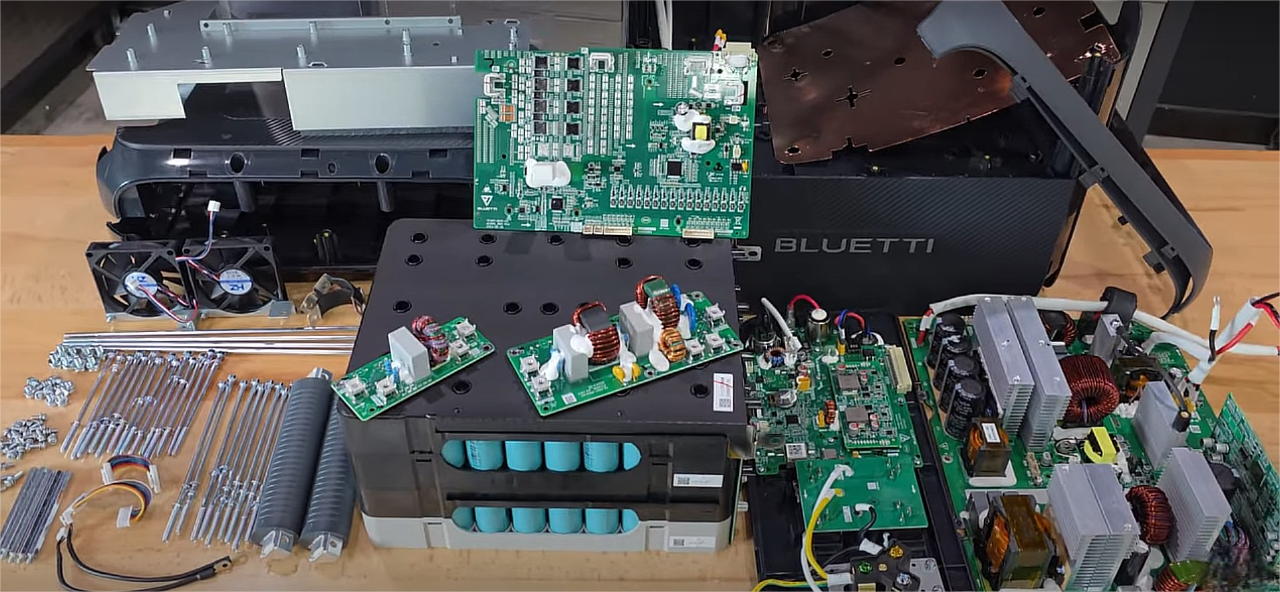When I first got my hands on the Bluetti AC200L, I knew I wasn’t just unboxing another portable power station—I was about to explore the kind of engineering that separates high-end products from the rest.

With its 2400-watt output and a 248 watt-hour LiFePO4 battery, this unit promised both power and safety. But as someone who’s been around battery tech for a while, I wanted to see exactly what was inside and why it commanded the trust of so many off-grid users.

What I found was a masterclass in design, from the battery pack to the inverter and even the small touches like anti-interference shielding. In this post, I’ll walk you through what I discovered, why it matters, and why—despite the DIY spirit in me—this teardown convinced me that some things are best left to the pros.
A Battery Pack Built for the Long Haul

Opening the Bluetti AC200L revealed a battery pack that was as impressive as it was compact. It’s built with 80 cylindrical LiFePO4 cells, each rated at 3.2 volts and 4 amp-hours, arranged in a series-parallel setup. That configuration delivers 51.2 volts and 40 amp-hours—perfect for balancing voltage and capacity without compromising portability.

Why LiFePO4? Simple:
- Thermal stability – Lower risk of overheating compared to other chemistries.
- Long cycle life – Thousands of charge cycles without significant degradation.
- Safety under stress – More tolerant of high discharge rates and environmental conditions.
From a practical standpoint, this chemistry choice makes the AC200L ideal for users who need dependable performance year after year.
Component Quality That Speaks for Itself

As I moved past the battery cells, what caught my attention was the choice of materials. Bluetti uses pure copper, tin-plated connectors with relief crimps. These aren’t just there for show—they’re designed to handle heat expansion and mechanical stress without loosening.
That’s something I rarely see in budget-friendly or DIY builds, where:
- Cheaper alloys can cause voltage drops.
- Poor crimps can lead to heat buildup.
- Long-term reliability takes a hit.
Bluetti’s approach here shows they’re thinking about how this unit performs not just on day one, but on day one thousand.
BMS: The Silent Guardian

One of the most critical components inside the AC200L is its Battery Management System (BMS). This is the brain that keeps the pack healthy and safe. It’s loaded with sensors and protection mechanisms for:
- Overvoltage and undervoltage prevention.
- Overcurrent and short-circuit protection.
- Temperature monitoring to prevent thermal runaway.

I’ve built battery packs before, and I can tell you—getting this level of integration and fail-safes right is no small feat. A DIY pack might run fine most of the time, but it rarely has the same resilience when things go wrong.
The Inverter: Power Without Compromise

If the battery pack is the heart of the AC200L, the inverter is its muscle. The main inverter board takes that 51.2V DC and turns it into smooth AC power capable of sustaining 2400 watts of continuous output.
This means I can:
- Run household appliances during outages.
- Power tools in off-grid projects.
- Keep sensitive electronics stable and interference-free.
Looking closely at the inverter’s layout, it’s clear this isn’t an afterthought—it’s engineered for efficiency, cooling, and reliability. That’s something you just can’t slap together in a garage without a lot of trial, error, and expense.
Shielding and Safety: Details That Matter

One detail I really appreciated was the anti-interference shielding plate between the battery pack and the upper electronics. This helps reduce electromagnetic interference (EMI), ensuring:
- Stable operation under load.
- Protection for sensitive circuits.
- Compliance with electromagnetic compatibility (EMC) standards.
In the DIY space, EMC is often ignored because it doesn’t show up until there’s a problem. Here, Bluetti bakes it into the design from day one.
DIY vs. Professional Manufacturing: The Reality Check
I’ll be honest—part of me loves the challenge of a good DIY build. But tearing down the AC200L was a humbling reminder of what it takes to match this level of integration:
- Precision engineering in component fit and layout.
- Safety certifications and compliance.
- Years of design refinement and testing.
Could I build something similar? Possibly. Could I do it safely, compactly, and cost-effectively? Probably not. The hidden costs, time, and potential safety risks make a strong case for going with a professional product like this.
Why Bluetti Earns My Trust
After going through every inch of the AC200L, I came away with three main reasons why I’d recommend it over most competitors:
- Engineering depth – Every component is chosen with purpose, not price alone.
- Safety systems – From the BMS to shielding, it’s built to protect both the user and itself.
- Brand reliability – Bluetti has a track record of innovation in portable power and solar integration.
For camping, backup power, or off-grid living, it’s not just about wattage—it’s about confidence that your system will work when you need it most.
Final Thoughts
Tearing down the Bluetti AC200L gave me a deep appreciation for the engineering behind today’s best portable power stations. This isn’t just a box of batteries and an inverter—it’s a finely tuned ecosystem of components working together for safety, performance, and longevity.
If you’re on the fence about whether to buy a ready-made power station or build your own, my advice is simple: watch a teardown like this, and you’ll see why the peace of mind and long-term reliability are worth the investment. For me, the AC200L isn’t just a tool—it’s a piece of engineering I genuinely trust.














